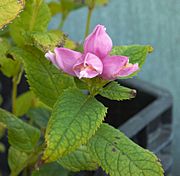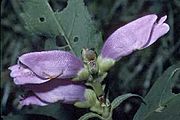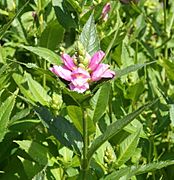Pink turtlehead facts for kids
Quick facts for kids Pink turtlehead |
|
|---|---|
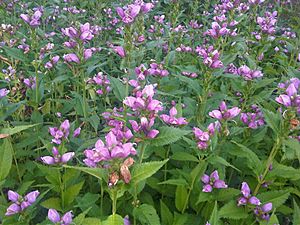 |
|
| Scientific classification | |
| Genus: |
Chelone
|
| Species: |
obliqua
|
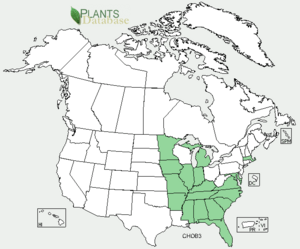 |
|
| Distribution of Chelone obliqua | |
Chelone obliqua, also known as the pink turtlehead, red turtlehead, or rose turtlehead, is a beautiful perennial flowering plant. This means it lives for more than two years. It belongs to the Plantaginaceae family. This special wildflower is found only in the United States. You can see it growing in the Midwest and southeastern states.
Its common names like "pink," "red," or "rose" turtlehead come from the color of its flowers. Sometimes, the blooms can even be purple or white! When the plant is flowering, its unique blossoms look a lot like the head of a turtle.
Contents
What Does the Turtlehead Plant Look Like?
Chelone obliqua is an herbaceous perennial. This means it has soft stems, not woody ones. It usually grows to be about 2 to 3 feet (60 to 90 cm) tall. The plant can also spread out, covering an area of 1 to 2 feet (30 to 60 cm) wide.
Stems and Leaves
The main stem of the plant is light green. It is smooth and has no hairs on it. Along the stem, you will find pairs of leaves growing opposite each other. These leaves often hang down a little. The leaves are shaped like a spear, or a wide spear, and are smooth. Their edges are serrated, meaning they have small, saw-like teeth. The top of each leaf is dark green, while the underside is a lighter green. A small stalk, called a petiole, connects each leaf to the stem.
Flowers and Seeds
Chelone obliqua blooms later in the year than many other plants. Its flowers appear in the middle to late summer. The flowers are shaped like tubes and have two "lips." Inside the lower lip, there is a small yellow, fuzzy patch. These flowers do not have a scent. Bees help to pollinate them, and butterflies are also attracted to their bright colors.
After the flowers turn brown and fall off, oval-shaped seed capsules grow. These capsules are light green at first and have no covering. Later, they turn brown and split open. This releases the seeds inside. The plant also spreads through its roots, forming new plants nearby.
Different Types of Turtlehead
There are a few different types, or varieties, of Chelone obliqua:
- Chelone obliqua var. erwiniae — This is called Erwin's red turtlehead. It is found in Kentucky, North Carolina, and South Carolina.
- Chelone obliqua var. obliqua — This is the red turtlehead found in the southeastern United States.
- Chelone obliqua var. speciosa — This is also a red turtlehead, found in the Midwest.
Where Does the Turtlehead Plant Grow?
Chelone obliqua is native to many states in the eastern and central parts of the United States. These include: Arkansas, Alabama, Florida, Georgia, Illinois, Iowa, Indiana, Kentucky, Massachusetts, Maryland, Michigan, Minnesota, Missouri, Mississippi, North Carolina, South Carolina, Tennessee, and Virginia.
It often grows in moist woods, swampy areas, and along streams.
Protecting the Turtlehead Plant
This beautiful wildflower has become quite rare. Because of this, it is considered threatened or endangered in some states by the United States Department of Agriculture.
For example:
- The Rose turtlehead is endangered in Arkansas and is a special concern in Kentucky.
- The Red turtlehead is endangered in Kentucky and threatened in Maryland.
- The Purple turtlehead is endangered in Michigan.
Being "endangered" means there are very few of these plants left. "Threatened" means it could become endangered soon if we don't protect it.
How to Grow Turtlehead Plants
Chelone obliqua is grown as an ornamental plant. This means people grow it in gardens because it is pretty. It blooms best in July and August.
Planting and Care
You can plant its seeds in early spring. You can also divide the plant in mid-spring or take cuttings from its soft tips in early summer.
This plant grows best in soil that is moist to wet. It also likes rich soil with lots of humus. Humus is dark, rich material from decayed plants and animals. It can grow in full sun or in areas with some shade. During the summer, it needs a lot of sunlight. It also needs wet, moist, or clay soil to grow well. The plant can grow in any pH conditions, whether the soil is neutral, alkaline, or acidic.
Common Problems
Sometimes, these turtlehead plants can have problems. They might get powdery mildew, which looks like white powder on the leaves. They can also get rust or fungal leaf spots. Slugs and snails might also try to eat the leaves, causing damage.
What Do the Names Mean?
The scientific name Chelone obliqua has interesting meanings:
- Chelone comes from the Greek word for "turtle-like." This refers to how the flowers look like a turtle's head.
- Obliqua means "slanting" or "having unequal sides."


